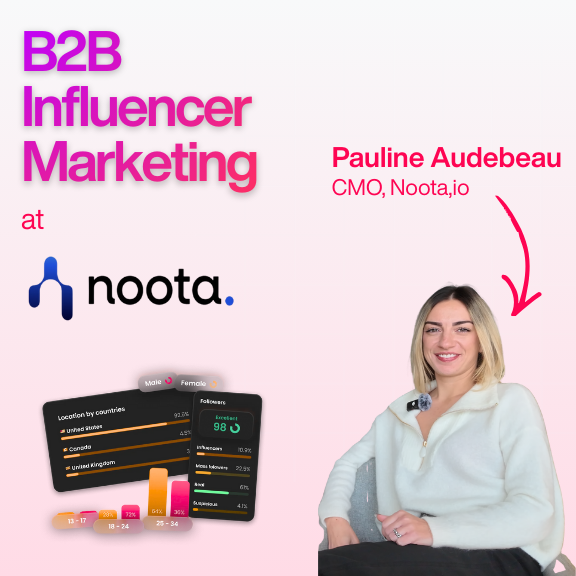Trouvez
Prenez les bonnes décisions pour identifier les meilleurs créateurs pour votre marque
Engagez
Lancez des campagnes, gérez les créateurs et suivez les résultats qui vous sont liés
Perspectives
Obtenez les informations dont vous avez besoin sur n'importe quel créateur ou marque, à tout moment et en tout lieu
Blog et articles
Votre ressource ultime pour l'économie des créateurs
Méthodologie et classements
À propos de Favikon, des classements, des outils et bien plus encore.
Perspectives
La recette du classement viral et convoité de Favikon.
Des outils gratuits pour dynamiser vos flux de travail de marketing d'influence.
Découvrez les réussites des utilisateurs de Favikon.
Accédez à tous les classements Favikon.
Devenez partenaire
Devenez un affilié
À propos de l'équipe à l'origine de Favikon
L'endroit où parler économie des créateurs, ensemble


Classements en vedette

Here is the Top 50 Rising Video Creators on LinkedIn. Video is quickly becoming the platform’s most powerful format, with creators gaining more reach and engagement than ever. As Gen Z grows its presence and tools like BrandLink and Thought Leader Ads support content creation, LinkedIn is doubling down on video. This ranking, made in partnership with OpusClip, celebrates the creators leading this shift and aims to inspire anyone ready to start sharing through video.

Here is the Top 50 Rising Video Creators on LinkedIn. Video is quickly becoming the platform’s most powerful format, with creators gaining more reach and engagement than ever. As Gen Z grows its presence and tools like BrandLink and Thought Leader Ads support content creation, LinkedIn is doubling down on video. This ranking, made in partnership with OpusClip, celebrates the creators leading this shift and aims to inspire anyone ready to start sharing through video.
Rapport de référence de Favikon sur l'engagement sur les réseaux sociaux
Téléchargez le rapport de référence sur l'engagement des influenceurs 2025 pour découvrir les niveaux les plus performants et des informations sur les plateformes pour une sélection plus intelligente des influenceurs.
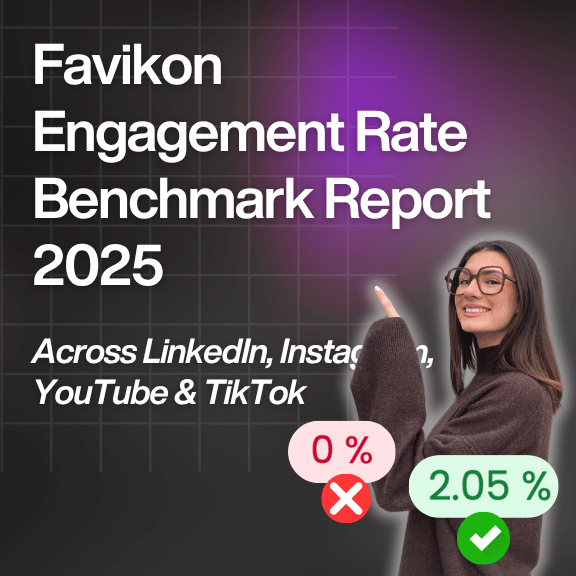


Sarthak Ahuja est un passionné de marketing qui contribue actuellement aux stratégies de marketing numérique de Favikon. Ancien élève de l'ESCP Paris avec plus de 2 ans d'expérience professionnelle, il a occupé plusieurs postes marketing dans différents secteurs. Les travaux de Sarthak ont été publiés dans des revues et des sites Web. Il aime lire et écrire sur des sujets concernant la durabilité, les affaires et le marketing. Vous pouvez le retrouver sur LinkedIn et Instagram.
Check Brand DealsRapport de référence sur le taux d'engagement de Favikon 2025
Résumé
Le rapport de référence 2025 de Favikon sur le taux d'engagement émerge à un point d'inflexion critique du marketing d'influence, où le secteur est confronté à des défis sans précédent liés au contenu généré par l'IA, à l'engagement synthétique et à l'évolution de la dynamique des plateformes. Cette analyse complète contextualise les résultats du rapport dans le contexte plus large du marché mondial du marketing d'influence de 32,55 milliards de dollars, en examinant comment la mesure authentique de l'engagement est devenue plus cruciale que jamais à l'ère de la manipulation artificielle.
Contexte du marché et validation
Trajectoire de croissance du secteur
Le secteur du marketing d'influence se trouve à la croisée des chemins. Avec une taille de marché estimée à 32,55 milliards de dollars en 2025 et un TCAC de 33,11 %, le secteur a connu une croissance sans précédent. La taille du marché des plateformes devrait atteindre 33 milliards de dollars en 2025.
L'accélération a été remarquable : la taille du marché mondial du marketing d'influence a plus que triplé depuis 2019. En 2024, le marché était estimé à 24 milliards de dollars américains, ouvrant la voie à une croissance explosive en 2025.
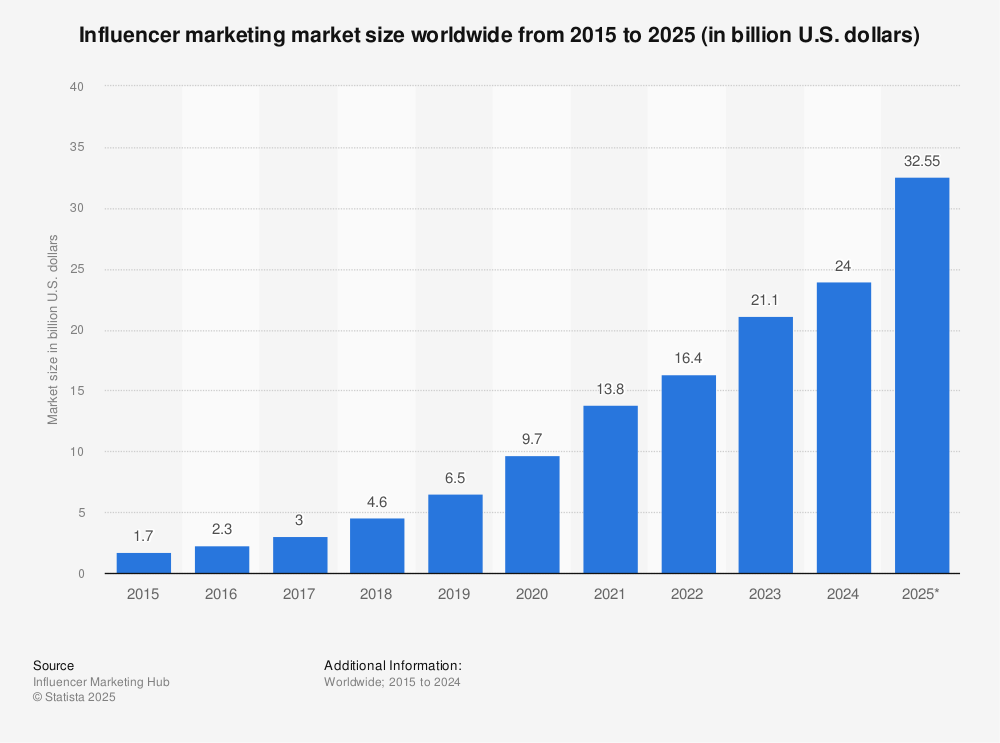
Réorientation de l'allocation budgétaire
L'affirmation du rapport selon laquelle 47 % des entreprises ont augmenté leurs budgets de plus de 11 % trouve un fort soutien de l'industrie. Plus de 50 % des marques prévoient d'augmenter les dépenses budgétaires consacrées aux créateurs en 2025, et 23 % des marques interrogées prévoyaient d'allouer plus de 40 % de leur budget marketing aux campagnes d'influence, soit une augmentation spectaculaire par rapport à seulement 5 % en 2022.
Cette réaffectation budgétaire reflète ce que les analystes du secteur décrivent comme une approche « la qualité plutôt que la quantité » qui reflète une tendance générale du secteur à la précision et à l'efficacité, les marques cherchant à optimiser leurs dépenses tout en préservant leur pertinence sur un marché concurrentiel.
La crise des taux d'engagement : pourquoi ces indices de référence sont importants
Le défi de l'authenticité
L'accent mis par le rapport sur les commentaires générés par l'IA et les indicateurs synthétiques faussant l'engagement reflète une véritable crise du secteur. Les influenceurs virtuels pilotés par l'IA transforment rapidement le paysage du marketing d'influence en introduisant des ambassadeurs de marque évolutifs, disponibles 24 heures sur 24, 7 jours sur 7, qui remettent en question les notions traditionnelles d'authenticité, d'engagement et d'alignement de la marque.
Ce problème d'engagement synthétique a créé ce que les experts du secteur décrivent comme un paradoxe de mesure : les taux d'engagement traditionnels sont de moins en moins fiables en tant qu'indicateurs d'une véritable connexion avec l'audience, ce qui rend l'analyse comparative relative (telle que fournie dans le rapport Favikon) essentielle pour une évaluation des performances significative.
Dynamique spécifique à la plateforme
Les informations spécifiques aux plateformes du rapport gagnent en pertinence lorsqu'elles sont comparées à l'évolution du paysage des réseaux sociaux en 2025 :
Instagram: Les données de Favikon révèlent que les nano-influenceurs (0 à 10 000 abonnés) atteignent des taux d'engagement dans le premier quartile de 3,4 % et plus, soit un taux nettement plus élevé que tout autre niveau. Ces 623 098 profils suivis avec 255 198 créateurs actifs démontrent la domination continue d'Instagram en matière de partenariats avec les influenceurs.
TikTok: La plateforme présente la volatilité d'engagement la plus extrême dans les données. Les nano-créateurs peuvent atteindre des pics extraordinaires de plus de 800 % d'engagement (premier quartile), tandis que les méga-influenceurs ont du mal à atteindre des taux de référence souvent inférieurs à 1,5 %. Cette gamme spectaculaire de 95 723 nano-profils suivis reflète l'algorithme viral de TikTok.
LinkedIn: Avec plus de 2,4 % de nano-profils provenant de 142 728 créateurs actifs dans le premier quartile, LinkedIn affiche un engagement remarquablement fort pour le contenu B2B, ce qui le rend de plus en plus précieux pour le marketing d'influence professionnel.
YouTube: La plateforme applique les normes d'engagement les plus prudentes à tous les niveaux, même le premier quartile des nano-créateurs commençant à seulement 0,8 %. Cela reflète l'accent mis par YouTube sur la consommation de contenu de longue durée, où la durée de visionnage et la rétention sont plus importantes que les réactions d'engagement immédiates.
Téléchargez le rapport complet
Perspectives approfondies : la transformation de l'économie des créateurs
L'avantage des nano-influenceurs
Les données de Favikon révèlent des tendances frappantes concernant la domination des nano-influenceurs sur toutes les plateformes :
- LinkedIn: Les nano-créateurs (0 à 10 000) obtiennent un taux d'engagement de plus de 2,4 % dans le premier quartile, sur la base de 142 728 profils actifs
- Instagram: Les nano-influenceurs du premier quartile atteignent 3,4 % d'engagement et plus auprès de 255 198 créateurs actifs
- TikTok: affiche des fourchettes extrêmes, les nano-créateurs atteignant jusqu'à 800 % et plus de pics d'engagement sur 55 443 profils actifs
- YouTube: Même les plus conservateurs de YouTube voient les nano-créateurs atteindre plus de 0,8 % dans le premier quartile
Ces données ne se limitent pas à des observations statistiques : elles reflètent des changements fondamentaux dans le comportement du public et des algorithmes des plateformes qui récompensent les relations authentiques et intimes entre le créateur et le public.
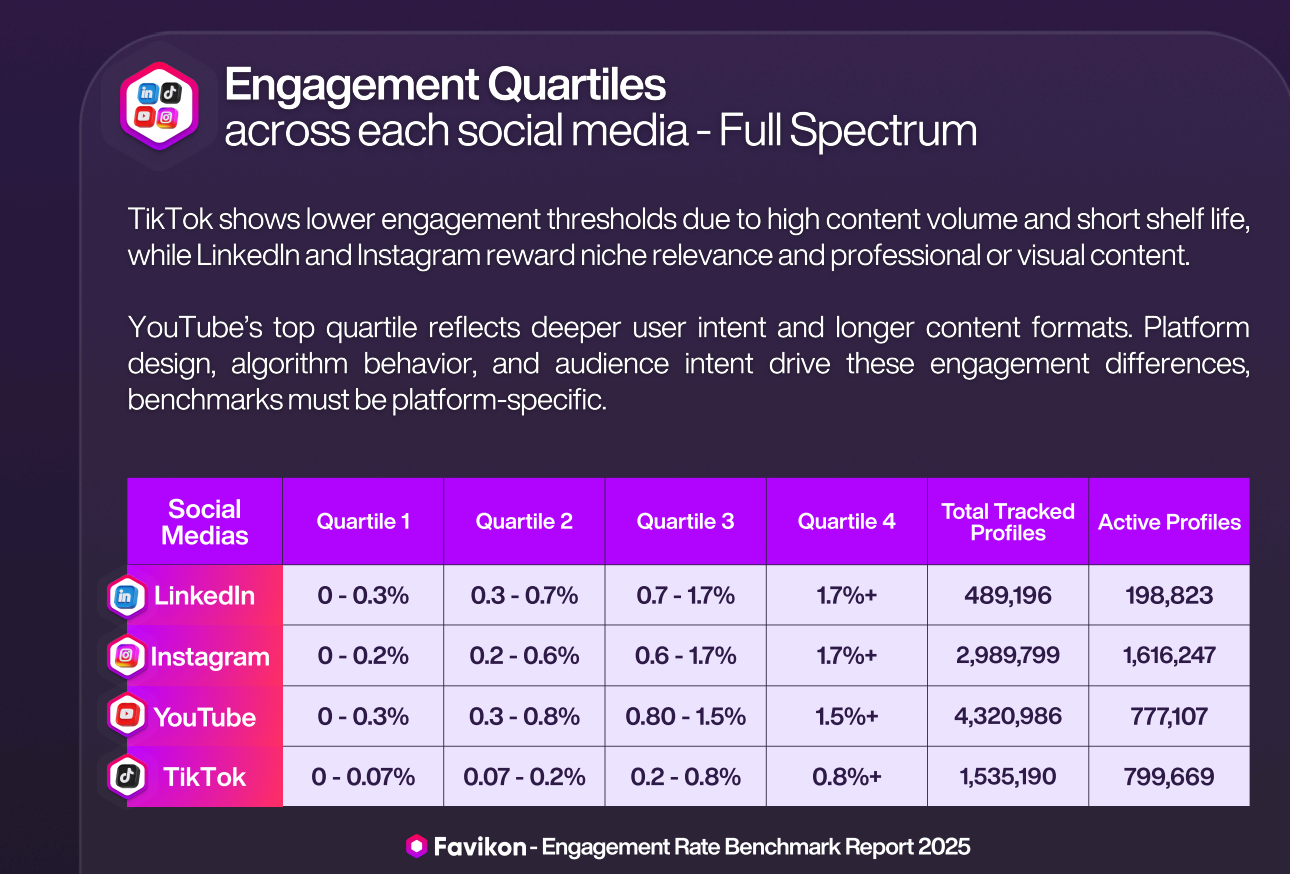
Le défi des méga-créateurs
Les données de Favikon illustrent clairement la baisse de l'engagement à grande échelle :
- LinkedIn: Les méga-créateurs (plus de 500 000) sont aux prises avec des taux de 0,15 % et plus dans le premier quartile, pour 333 profils actifs seulement
- Instagram: Les méga-influenceurs se stabilisent à 1,8 % + engagement maximum malgré 71 428 créateurs actifs
- YouTube: Les grands créateurs conservent des performances légèrement meilleures à 0,5 % et plus, mais restent nettement inférieures à celles des niveaux nanométriques
- TikTok: Même les créateurs de méga TikTok dépassent rarement 1,5 % d'engagement dans le premier quartile
Ce « paradoxe des célébrités » révèle la réalité mathématique de l'engagement à grande échelle, où la dilution de l'audience, les limites des algorithmes et l'impossibilité d'établir une connexion personnelle créent des limites d'engagement naturelles, quelle que soit la qualité du contenu.
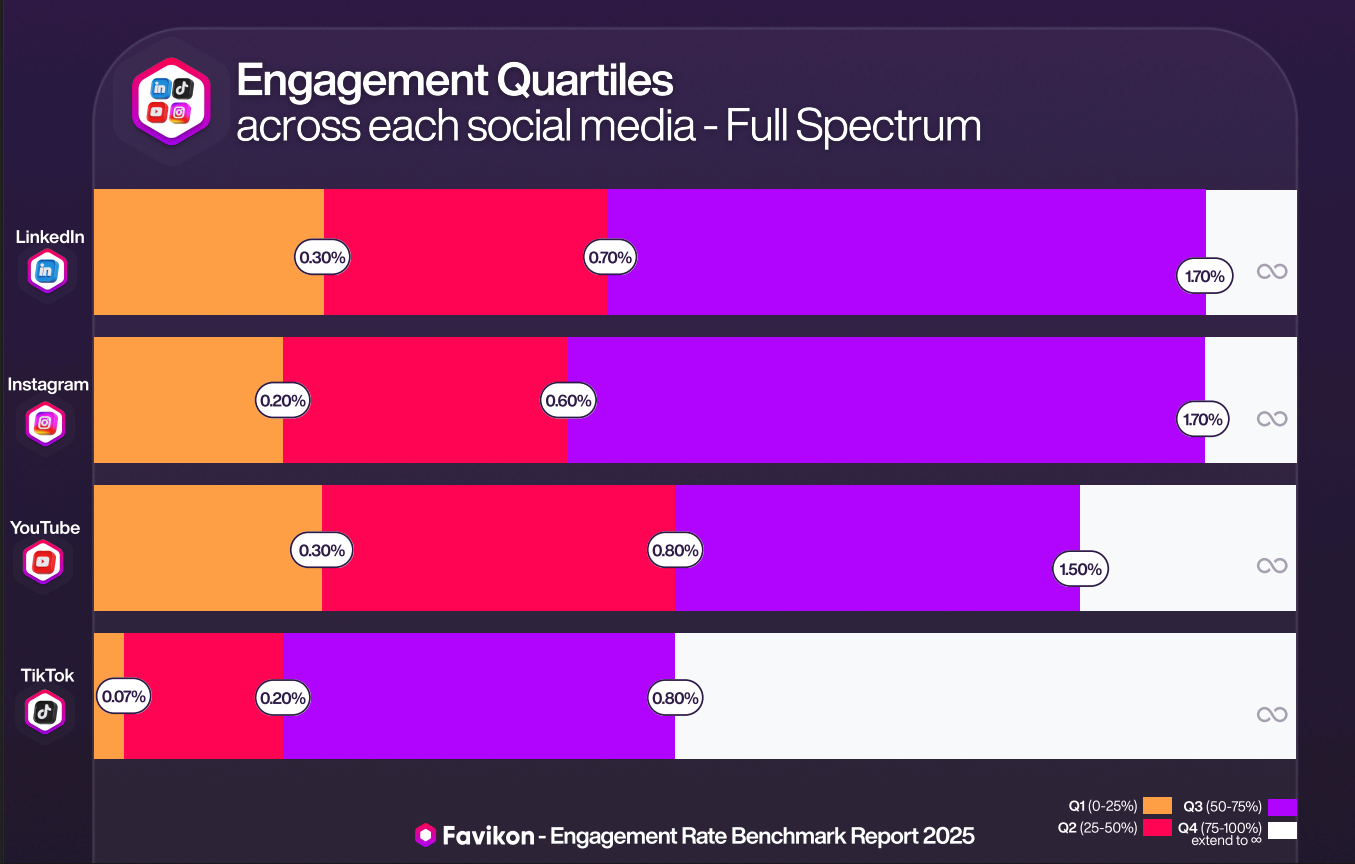
La disruption de l'IA : le défi majeur de 2025
Contenu généré par l'IA et engagement synthétique
L'essor du contenu généré par l'IA pose des défis sans précédent en matière de mesure de l'engagement. Le marché mondial des influenceurs basés sur l'IA devrait atteindre 1,5 milliard de dollars d'ici 2025, tandis que 52,8 % des marketeurs pensent que les influenceurs IA ont un impact significatif sur l'avenir du marketing et du divertissement.
Cependant, cette croissance s'accompagne de sérieux problèmes d'authenticité. Parce qu'ils sont entièrement contrôlés par des algorithmes, les influenceurs basés sur l'IA ne peuvent pas fournir de véritables recommandations ou critiques de produits ou services. Le défi va au-delà des personnages basés sur l'IA, mais concerne l'engagement généré par l'IA lui-même, où les problèmes de transparence, tels que la capacité des abonnés à reconnaître facilement un influenceur basé sur l'IA comme un non-humain, entrent en jeu.
Détection d'engagement synthétique
L'accent mis par le rapport sur les commentaires générés par l'IA reflète les préoccupations croissantes de l'industrie. Les marques doivent désormais :
- Qualité de la mission d'audit: Au-delà des chiffres bruts, il faut évaluer l'authenticité des commentaires
- Mettre en œuvre des outils de détection: Utilisation de l'IA pour identifier les interactions générées par l'IA
- Recherchez la transparence: Travailler avec des créateurs qui divulguent leur utilisation des outils d'IA
Découvrez comment Favikon détecte l'engagement synthétique grâce aux scores d'authenticité
Implications stratégiques pour 2025
Pour les marques et les directeurs marketing
Les critères de référence du rapport fournissent un cadre pour naviguer dans le paysage complexe des créateurs en 2025 :
- Stratégie basée sur les niveaux: utilisez les données du quartile pour identifier les créateurs sous-évalués dans des plages d'abonnés spécifiques
- Objectifs spécifiques à la plateforme: Ajustez les KPI en fonction des normes de la plateforme plutôt que des repères universels
- Métriques de qualité: Concentrez-vous sur l'authenticité de l'engagement plutôt que sur les chiffres absolus
Pour les agences
Les données d'analyse comparative permettent de planifier des campagnes de manière plus sophistiquée :
- Précision de la proposition: Recommandations fondées sur des données de performance vérifiées
- Éducation des clients: Utilisez des points de repère pour définir des attentes réalistes
- Optimisation des performances: Identifiez les créateurs dont les performances se situent régulièrement au-dessus des points de référence du quartile
Pour les créateurs
La compréhension de ces critères aide les créateurs à :
- Négociation des tarifs: Utilisez le positionnement par quartile pour justifier les prix
- Stratégie de plateforme: Concentrez vos efforts sur les plateformes où elles dépassent les critères de référence
- Planification de la croissance: Comprenez comment l'engagement évolue généralement en fonction de l'échelle
Mesure de l'engagement à l'épreuve du temps
Au-delà des indicateurs traditionnels
L'approche du rapport en matière d'analyse comparative relative prévoit un avenir dans lequel :
- Le contexte compte davantage: Les normes spécifiques à la plateforme et au niveau deviennent essentielles
- La qualité prime sur la quantité: L'authenticité de l'engagement prend plus de valeur que le volume
- Analyse comparative dynamique: les mises à jour régulières tiennent compte des modifications apportées à l'algorithme de la plateforme
Indicateurs émergents
2025 pourrait voir apparaître de nouveaux indicateurs de qualité de l'engagement :
- Profondeur de réponse: longueur moyenne des commentaires et profondeur du fil de conversation
- Cohérence multiplateforme: modèles d'engagement sur de multiples plateformes
- Chevauchement des audiences: Mesurer les abonnés authentiques par rapport aux abonnés robots grâce à l'analyse du comportement
Faire face à la nouvelle réalité de l'engagement
Le rapport de référence 2025 de Favikon sur le taux d'engagement, qui analyse plus de 6 millions de profils sur Instagram, TikTok, LinkedIn et YouTube, fournit des outils de navigation essentiels pour un secteur confronté à une transformation sans précédent. La méthodologie du rapport, qui se concentre sur les créateurs actifs (publiés dans les 30 jours) et utilise une discrétisation basée sur les quantiles sur 12 plages d'abonnés personnalisées, offre la précision requise pour le paysage complexe de 2025.
Principales conclusions de l'ensemble de données complet :
- Impact sur l'échelle: relation inverse claire entre le nombre d'abonnés et l'engagement sur toutes les plateformes
- Variante de plateforme: Des différences considérables dans les normes d'engagement (0,8 % du nano-quartile supérieur de YouTube contre un potentiel de 800 % et plus pour TikTok)
- Niveaux de création: repères précis pour les segments nano (0-10K), micro (10-100K), macro (100K-500K) et méga (500K+)
- Segmentation granulaire: répartition détaillée de 12 plages d'abonnés spécifiques permettant une évaluation précise des créateurs
Le calendrier du rapport coïncide parfaitement avec la taille du marché de 32,55 milliards de dollars du secteur et répond au principal défi que représente le maintien de mesures authentiques dans un environnement saturé d'IA. En fournissant des points de référence fiables pour un véritable engagement sur un total de 8,3 millions de profils suivis auprès de plus de 2,6 millions de créateurs actifs, il aide les marques, les agences et les créateurs à se concentrer sur l'établissement de véritables relations avec un public réel.
Vérifiez les taux d'engagement et la qualité de n'importe quel créateur sur Favikon
Ressources clés de l'industrie et lectures complémentaires
Rapports et études essentiels
- Rapport de référence 2025 du Influencer Marketing Hub - Analyse complète du secteur avec 265 avis d'experts
- Analyse du marché de Mordor Intelligence - Projette une croissance du marché à 121,81 milliards de dollars d'ici 2030
- Étude de la plateforme de recherche Grand View - Prévoit que le marché des plateformes atteindra 97,55 milliards de dollars d'ici 2030
Sources de données et de statistiques
- Statistiques de Statista sur le marketing d'influence - Données et tendances du marché mondial
- Statistiques de Sprout Social 2025 - 29 statistiques clés pour la stratégie de marque
- Analyses sectorielles DemandSage - Plus de 30 statistiques mises à jour pour 2025
Analyse de l'IA et des tendances futures
- Rapport WFA AI Essentials - Considérations réglementaires et éthiques
- Analyse de Stack Influence AI - Une analyse approfondie des implications de l'IA pour les influenceurs
- Statistiques du marché d'ArtSmart AI - Projections et défis du marché des influenceurs IA
Méthodologie et mesures
- Critères d'engagement de Favikon - Accédez à l'ensemble de données sur les taux d'engagement
- Guide marketing sur l'IA pour Influencer Hero - Stratégies de mise en œuvre pratiques
- Trouvez votre influence sur les tendances 2025 - Défis et opportunités de l'industrie
Related Articles
See all the articles










.png)
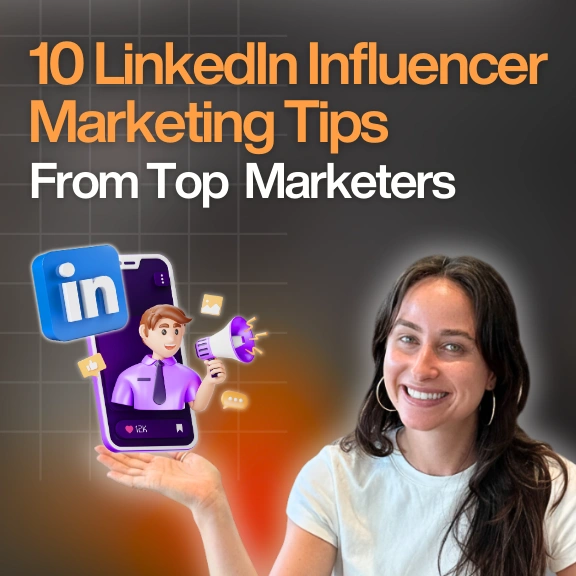





.png)
